Research on the Location-Routing Optimization of International Freight Trains Considering the Implementation of Blockchain
Abstract
1. Introduction
2. Literature Review
2.1. Location-Routing Optimization of International Freight Trains
2.2. Implementation of Blockchain Technology in the Transportation Industry
2.3. Literature Summary
3. Problem and Parameter Description
- (1)
- All train formations are at the same level.
- (2)
- The goods are transported by train to the assembly center or the destination station.
- (3)
- Goods are picked up when they arrive at their destination with no waiting times or storage fees.
4. Model Building
5. Solving Algorithm
5.1. Opposition-Based Learning Mechanism
5.2. Calculation of Dominance Intensity
5.3. Improved Calculation of Crowding Degree
5.4. Adaptive Elite Retention Strategy
6. Case Analysis
6.1. Data Sources
6.2. Parameter Settings
6.3. Comparison of Algorithm Performance
| Algorithm 1. The implementation process of the algorithm |
| Input values of the main parameters and topological network of transportation network |
| 1. Set the population size and dimension, and initialize the population according to the constraints (18)–(34), |
| 2. Set the maximum number of iterations , let the current number of iterations , |
| 3. Non-dominant ranking of individuals in the initial population, |
| 4. Calculating the jumping rate according to Equation (36), and determine whether , |
| 4.1 If , |
| 4.1.1 Calculating the dominant intensity according to Equation (39), |
| 4.1.2 Calculating the crowding degree according to Equation (40), |
| 4.1.3 Comparing the non-dominance rank, dominance intensity, and crowding degree sequentially, and sorting the individuals, |
| 4.1.4 Calculating the generation elite individual retention size according to Equations (41) and (42), |
| 4.1.5 Merging populations, let , turn into 5, |
| 4.2 Else if , |
| 4.2.1 According to the non-dominant ordering, the population was divided into the non-dominant set and other individual set , |
| 4.2.2 Traverse through all individuals in set , and calculating the probability of opposition-based learning according to Equations (37) and (38), |
| 4.2.3 Determine whether , |
| 4.2.4 If , calculating the opposite solution according to Equation (35) and constraints (18)–(34), and add it into set , |
| 4.2.5 Merging the set and , |
| 4.2.6 Non-dominant ordering of individuals in the merged set, then turn into 4.1.1. |
| 5 Determine whether , |
| 5.1 If , turn into 3, |
| 5.2 Else if, end. |
| Output optimized solution |
6.4. Results
6.4.1. Optimization Results When Blockchain Technology Is Not Applied
6.4.2. Optimization Result After Applying Blockchain Technology
6.5. Sensitivity Analysis
7. Conclusions
Author Contributions
Funding
Data Availability Statement
Acknowledgments
Conflicts of Interest
References
- Storto, L.; Evangelista, P. Infrastructure Efficiency, Logistics Quality and Environmental Impact of Land Logistics Systems in the EU: A DEA-based Dynamic Mapping. Res. Transp. Bus. Manag. 2023, 46, 100814. [Google Scholar] [CrossRef]
- Wei, J.; Wang, Y. Achievements, Experiences and Prospects of China-Europe Railway Express in the Context of the “Belt and Road” Initiative. J. Beijing Jiaotong Univ. 2023, 22, 19–27. [Google Scholar]
- Tjia, L. Fragmented but Enduring Authoritarianism: Supply-side Reform and Subnational Entrepreneurialism in China’s Rail Delivery Services. China Q. 2023, 256, 905–918. [Google Scholar] [CrossRef]
- Dong, W.; Zhang, Z. Is China’s International Trade Exacerbating Urban Environmental Pollution? - A Quasi-natural Experiment Based on the Opening of the China Railway Express. J. Clean. Prod. 2023, 406, 137159. [Google Scholar] [CrossRef]
- Zhao, L.; Zhao, Y.; Hu, Q.; Li, H.; Stoeter, J. Evaluation of Consolidation Center Cargo Capacity and Locations for China Railway Express. Transp. Res. Part E Logist. Transp. Rev. 2018, 117, 58–81. [Google Scholar] [CrossRef]
- Hilmola, O.P.; Li, W.; Panova, Y. Development Status and Future Trends for Eurasian Container Land Bridge Transport. Logistic 2021, 5, 18. [Google Scholar] [CrossRef]
- Xiao, C.; Wang, Y.; Yan, M.; Chiaka, J.C. Impact of Cross-border Transportation Corridors on Changes of Land Use and Landscape Pattern: A Case Study of the China-Laos Railway. Landsc. Urban Plan. 2024, 241, 104924. [Google Scholar] [CrossRef]
- Zhang, L.; Wan, J.; Razzaq, A.; Zhang, Q.; Zhou, L.; Erfanian, S. Exploring the Impact of China-Europe Railway Express on the Urban-rural Income Gap. Heliyon 2023, 9, e17571. [Google Scholar] [CrossRef]
- Zhao, M.L.; Liu, Q.X.; Sun, W.; Wulazi, G. The Impact of the Opening of China Railway Express on the Export Trade of Cities Along the Rail Line in China and the Mechanism Test. Acta Geogr. Sin. 2023, 78, 1427–1442. [Google Scholar]
- Cheng, Z.L.; Zhao, L.J.; Li, H.Y. Key Factors that Influence the Performance of China Railway Express Operations: Case Studies of Ten Lines in China. Int. J. Shipp. Transp. Logist. 2022, 14, 395–431. [Google Scholar] [CrossRef]
- Zhou, Y.W.; Li, J.C.; Zhong, Y.G. Cooperative Advertising and Ordering Policies in a Two-echelon Supply Chain with Risk-averse Agents. Omega-Int. J. Manag. Sci. 2018, 75, 97–117. [Google Scholar] [CrossRef]
- Liu, Z.H.; Wang, G.S.; Wei, M.H. The Development of Intelligent Railway Transport System. Control Autom. 2006, 172, 16. [Google Scholar]
- Umiliacchi, P.; Henning, U.; Roberts, C.; Shingler, R. Optimisation of the Railway System Through Better Integration and Communication: First Results from the Integral European Project. In Proceedings of the 13th ITS World Congress, London, UK, 8–12 October 2006. [Google Scholar]
- Qin, Y.; Cao, Z.W.; Sun, Y.F.; Kou, L.L.; Zhao, X.J.; Wu, Y.P.; Liu, Q.H.; Wang, M.M.; Jia, L.M. Research on Active Safety Methodologies for Intelligent Railway Systems. Engineering 2023, 27, 266–279. [Google Scholar] [CrossRef]
- Shi, T.Y.; Zhang, H.Y.; Jia, L.M. Railway Intelligent Transport System in Japan-CyberRail Framework and Research Status. China Railw. Sci. 2003, 24, 82–88. [Google Scholar]
- China State Railway Group Co., Ltd. Issues the ‘14th Five Year Plan for Railway Network Security and Informatization’. Available online: http://www.china-railway.com.cn/xwzx/zhxw/202205/t20220512_121575.html (accessed on 12 May 2022).
- Kim, S.; Kim, D. Securing the Cyber Resilience of a Blockchain-based Railroad Non-stop Customs Clearance System. Sensors 2023, 23, 2914. [Google Scholar] [CrossRef]
- Hong, Z.C.; Zhang, J.; Sun, W.J.; Shen, H.; Zhao, G.; Liang, H.B. China Railway Express Network Flow Assignment in Blockchain Background. Transp. Syst. Eng. Inf. Technol. 2023, 23, 270–281. [Google Scholar]
- Zhou, J.; Jiang, Y.J.; Shen, Y.X.; Pantelous, A.A.; Liu, Y.Y.; Huang, C.; Mei, L. Mei Intermodal Hub-and-spoke Logistic Network Design with Differentiated Services: The Case of China Railway Express. Inf. Sci. 2022, 612, 796–815. [Google Scholar] [CrossRef]
- Muravev, D.; Hu, H.; Zhou, H.; Pamucar, D. Location Optimization of CR Express International Logistics Centers. Symmetry 2020, 12, 143. [Google Scholar] [CrossRef]
- Wu, Y.H.; Lin, C.; Huang, J.Y. Network Planning Location Model for China Railway Express. Transp. Res. Rec. 2019, 2673, 263–274. [Google Scholar] [CrossRef]
- Wei, Y.G.; Gu, Y.K.; Xia, Y.; Zhang, Q. Research on Transportation Organization Optimization for China Railway Express Based on Hub Assembling. J. China Railw. Soc. 2022, 44, 17–25. [Google Scholar]
- Cheng, Z.L.; Zhao, L.J.; Wang, G.X.; Li, H.Y.; Hu, Q.M. Selection of Consolidation Center Locations for China Railway Express to Reduce Greenhouse Gas Emission. J. Clean. Prod. 2021, 305, 126872. [Google Scholar] [CrossRef]
- Ma, J.; Wang, X.; Yang, K.; Jiang, L. Uncertain Programming Model for the Cross-Border Multimodal Container Transport System Based on Inland Ports. Axioms 2023, 12, 132. [Google Scholar] [CrossRef]
- Orji, I.J.; Kusi-Sarpong, S.; Huang, S.F.; Vazquez-Brust, D. Evaluating the Factors that Influence Blockchain Adoption in the Freight Logistics Industry. Transp. Res. Part E Logist. Transp. Rev. 2020, 141, 102025. [Google Scholar] [CrossRef]
- Ahmad, R.W.; Hasan, H.; Jayaraman, R.; Salah, K.; Omar, M. Blockchain Applications and Architectures for Port Operations and Logistics Management. Res. Transp. Bus. Manag. 2021, 41, 100620. [Google Scholar] [CrossRef]
- Lohmer, J.; Bugert, N.; Lasch, R. Analysis of Resilience Strategies and Ripple Effect in Blockchain-coordinated Supply Chains: An Agent-based Simulation Study. Int. J. Prod. Econ. 2020, 228, 107882. [Google Scholar] [CrossRef]
- Abramović, B.; Zitricky, V.; Biškup, V. Organisation of railway freight transport: Case study CIM/SMGS between Slovakia and Ukraine. Eur. Transp. Res. Rev. 2016, 8, 27. [Google Scholar] [CrossRef]
- Zhao, L.J.; Stoeter, J.; Li, H.Y.; Hu, Q.M.; Cheng, Z.L.; Wang, X.L. European Hub Location Problem for China Railway Express in the Context of the Belt and Road Initiative. Int. J. Logist. Res. Appl. 2020, 23, 561–579. [Google Scholar] [CrossRef]
- Zhang, X.F.; Lu, J.; Peng, Y. Hybrid MCDM Model for Location of Logistics Hub: A Case in China Under the Belt and Road Initiative. IEEE Access 2021, 9, 41227–41245. [Google Scholar] [CrossRef]
- Tang, Y.Y.; Chen, S.; Lu, G.Y.; Zhang, Q.S. Research on Hub-and-Spoke Transportation Network of China Railway Express. J. Adv. Transp. 2021, 2021, 8830561. [Google Scholar] [CrossRef]
- Lu, Y.; Lang, M.X.; Yu, X.Q.; Li, S.Q. A Sustainable Multimodal Transport System: The Two-Echelon Location-Routing Problem with Consolidation in the Euro–China Expressway. Sustainability 2019, 11, 5486. [Google Scholar] [CrossRef]
- Fattahi, Z.; Behnamian, J. Location and Transportation of Intermodal Hazmat Considering Equipment Capacity and Congestion Impact: Elastic Method and Sub-population Genetic Algorithm. Ann. Oper. Res. 2022, 316, 303–341. [Google Scholar] [CrossRef]
- Fazayeli, S.; Eydi, A.; Kamalabadi, I.N. Location-Routing Problem in Multimodal Transportation Network with Time Windows and Fuzzy Demands: Presenting a Two-Part Genetic Algorithm. Comput. Ind. Eng. 2018, 119, 233–246. [Google Scholar] [CrossRef]
- Zhu, S.; Song, M.L.; Lim, M.K.; Wang, J.L.; Zhao, J.J. The Development of Energy Blockchain and its Implications for China’s Energy Sector. Resour. Policy 2020, 66, 101595. [Google Scholar] [CrossRef]
- Elghaish, F.; Abrishami, S.; Hosseini, M.R. Integrated Project Delivery with Blockchain: An Automated Financial System. Autom. Constr. 2020, 114, 103182. [Google Scholar] [CrossRef]
- Kuo, T.T.; Kim, H.E.; Ohno-Machado, L. Blockchain Distributed Ledger Technologies for Biomedical and Health Care Applications. J. Am. Med. Inform. Assoc. 2017, 24, 1211–1220. [Google Scholar] [CrossRef]
- Zhang, Y.; Liu, N. Blockchain Adoption in Serial Logistics Service Chain: Value and Challenge. Int. J. Prod. Res. 2023, 61, 4374–4401. [Google Scholar] [CrossRef]
- Hong, Z.C.; Li, H.; Zhang, J.; Chen, H.J. Risk Evaluation Model of Blockchain Integration Based on CKKS Encryption Scheme. J. Southwest Jiaotong Univ. 2023, 58, 100–108. [Google Scholar]
- Khan, J.A.; Wang, W.Y.; Ozbay, K. BELIEVE: Privacy-aware secure multi-party computation for real-time connected and autonomous vehicles and micro-mobility data validation using blockchain-a study on New York City data. Transp. Res. Rec. 2023, 2678, 410–421. [Google Scholar] [CrossRef]
- Wamba, S.F.; Queiroz, M.M.; Trinchera, L. Dynamics Between Blockchain Adoption Determinants and Supply Chain Performance: An Empirical Investigation. Int. J. Prod. Econ. 2020, 229, 107791. [Google Scholar] [CrossRef]
- Chen, Y.J.; Yang, B. Analysis on the Evolution of Shipping Logistics Service Supply Chain Market Structure Under the Application of Blockchain Technology. Adv. Eng. Inform. 2022, 53, 101714. [Google Scholar] [CrossRef]
- Rahnamayan, S.; Tizhoosh, H.R.; Salama, M.M. Opposition-based Differential Evolution Algorithms. In Proceeding of the IEEE Congress on Evolutionary Computation, Vancouver, BC, Canada, 16–21 July 2006. [Google Scholar]
- Cai, Z.S.; Dai, L.Q.; Liu, H.B.; Dai, H.C.; Dong, Q.J.; Wang, Y. Application of Improved NSGA-II algorithm Based on Dominance Strength in Multi-objective Operation of Cascade Reservoirs. Eng. J. Wuhan Univ. 2021, 54, 999–1007. [Google Scholar]
- Yan, W.; Zhu, X.N.; Deng, Y.J.; Wang, L. Optimization Model of Outbound Transportation Organization for China Railway Express. J. China Railw. Soc. 2019, 41, 1–7. [Google Scholar]
- Gopalakrishnan, P.K.; Hall, J.; Behdad, S. Cost Analysis and Optimization of Blockchain-based Solid Waste Management Traceability System. Waste Manag. 2021, 120, 594–607. [Google Scholar] [CrossRef] [PubMed]
- Naoki, T.; Noriyuki, F. Traceability Management System Using Blockchain Technology and Cost Estimation in the Metrology Field. Sensors 2023, 23, 1673. [Google Scholar] [CrossRef] [PubMed]
- Lee, P.T.; Lam, J.S.L.; Lin, C.W.; Hu, K.C.; Cheong, I. Developing the fifth generation port concept model: An empirical test. Int. J. Logist. Manag. 2018, 29, 1098–1120. [Google Scholar] [CrossRef]
- Yang, Y.S.; Zhong, M.S.; Yao, H.Q.; Yu, F.; Fu, X.W.; Postolache, O. Postolache Internet of things for smart ports: Technologies and challenges. IEEE Instrum. Meas. Mag. 2018, 21, 34–43. [Google Scholar] [CrossRef]
- Yang, C.S. Maritime shipping digitalization: Blockchain-based technology applications, future improvements, and intention to use. Transp. Res. Part E Logist. Transp. Rev. 2019, 131, 108–117. [Google Scholar] [CrossRef]
- Li, K.P.; Lee, J.Y.; Gharehgozli, A. Blockchain in food supply chains: A literature review and synthesis analysis of platforms, benefits and challenges. Int. J. Prod. Res. 2023, 61, 3527–3546. [Google Scholar] [CrossRef]
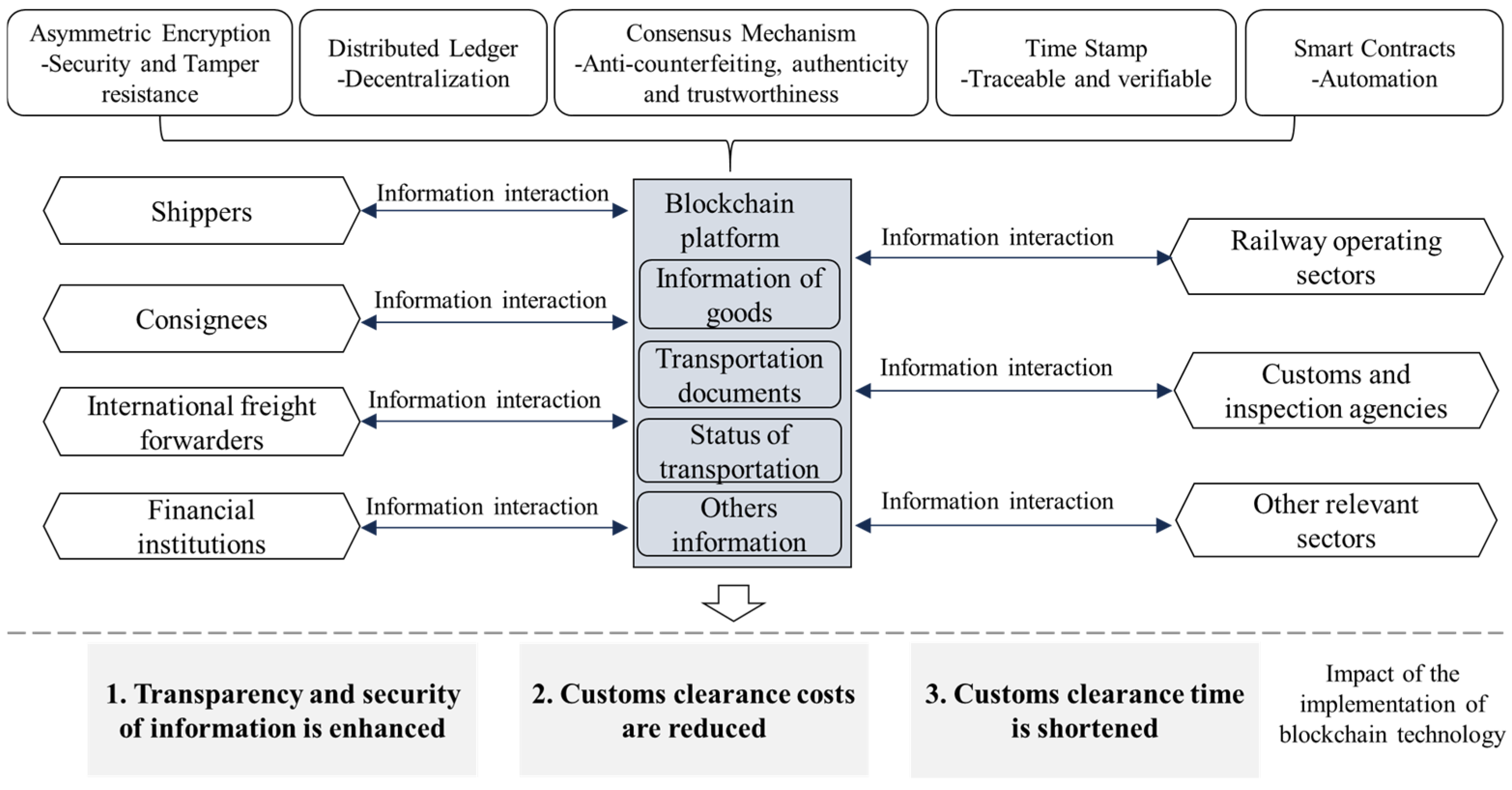
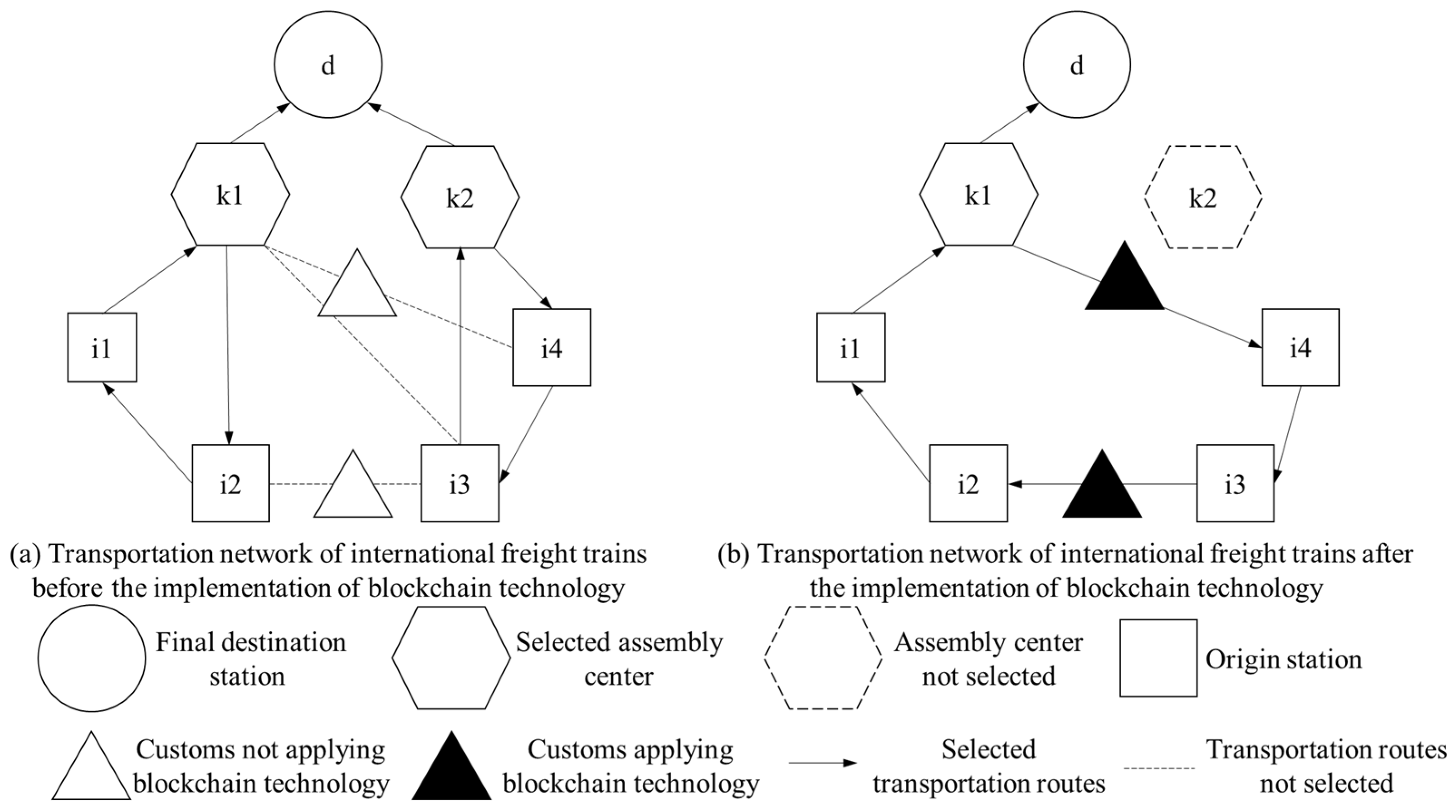
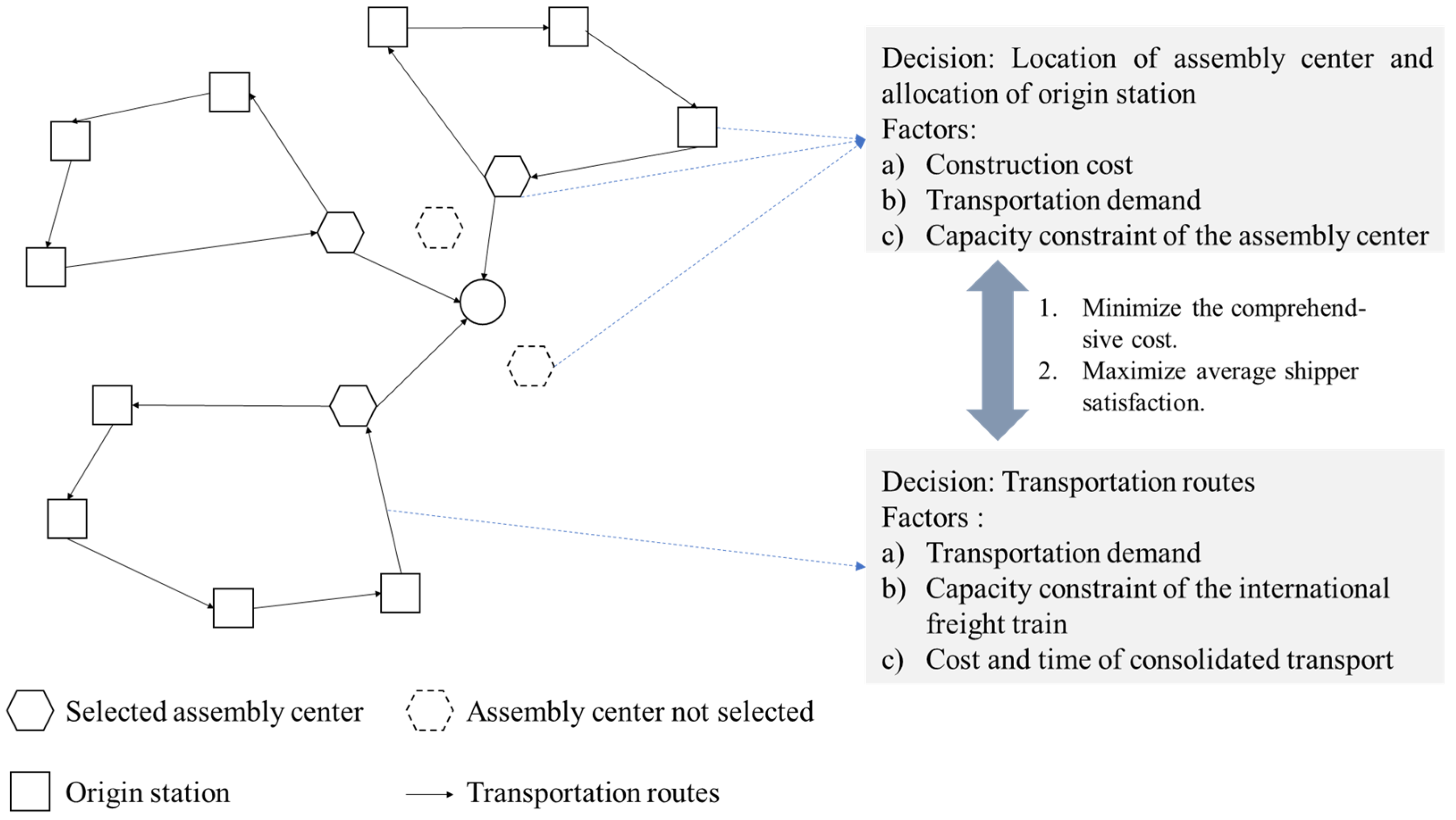
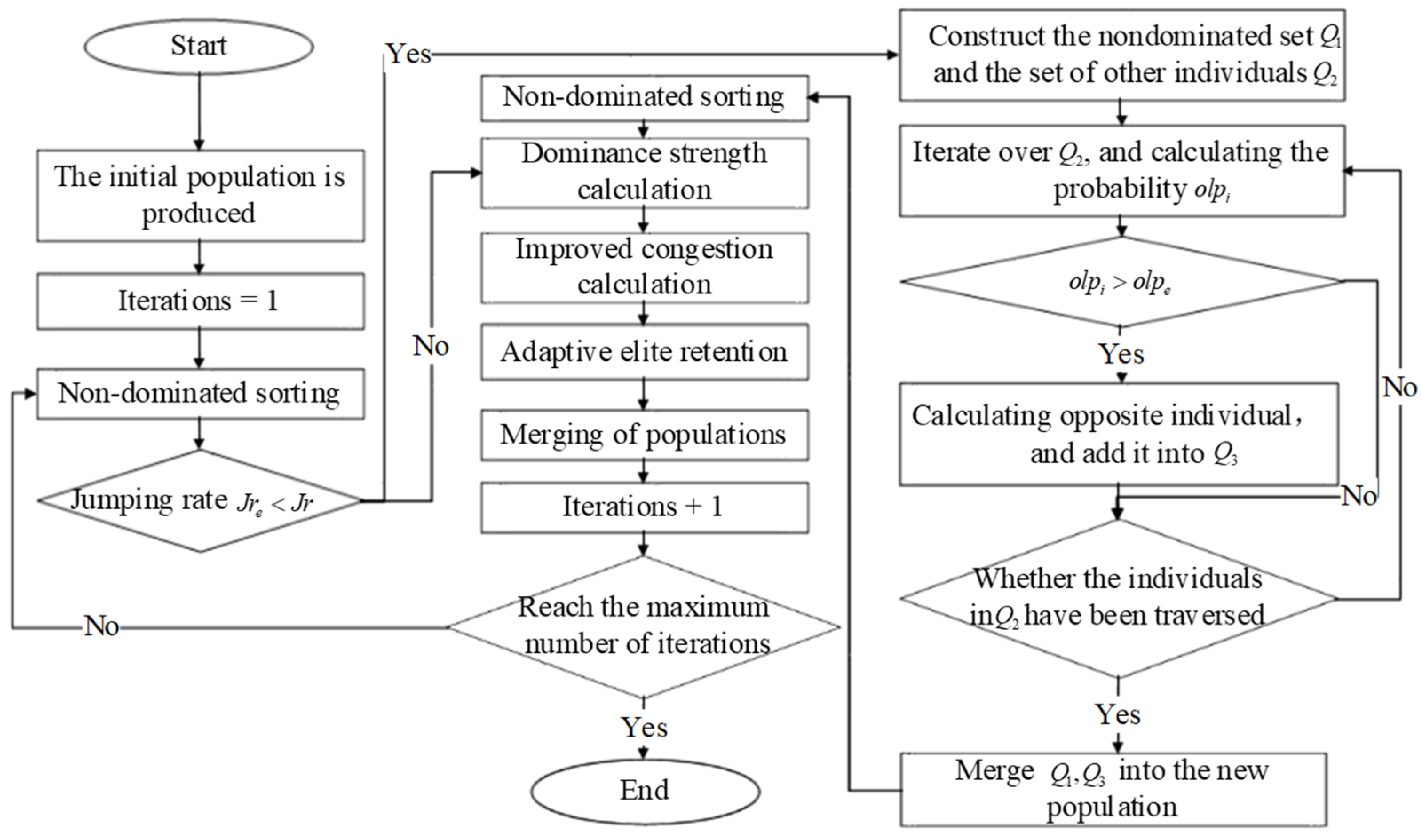
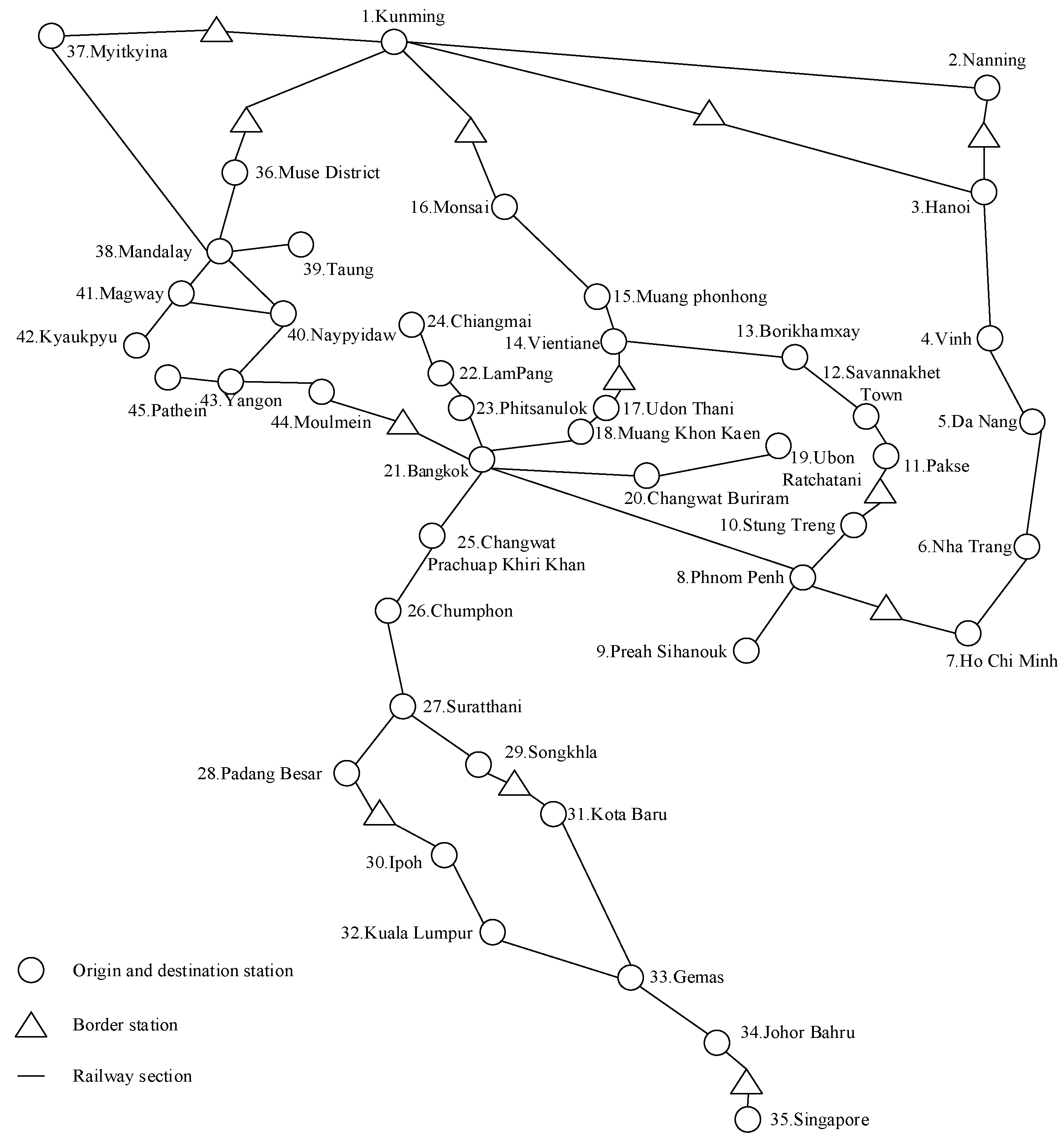





| Typology | Symbol | Meaning | Typology | Symbol | Meaning |
|---|---|---|---|---|---|
| Sets | Set of origin station | Parameters | Fee of cross-border clearance, CNY/TEU | ||
| Set of candidate points of assembly centers | Proportion reduction in the fee of cross-border clearance after the implementation of blockchain technology | ||||
| Set of the final destination station | Fee of train formation, CNY/TEU | ||||
| Set of originating stations in the assembly transportation route of the origin station | Fee of blockchain technology, CNY/TEU | ||||
| Variables | Cargo volume from origin to destination | Construction fee of assembly center | |||
| Transport miles from to | Maximum number of formations allowed, TEU | ||||
| Congested waiting times at origin | Profit generated by transporting a unit of goods over a unit distance, CNY/(TEU·km) | ||||
| Congested waiting times at assembly center | Loading fee at origin | ||||
| Waiting time for transportation at assembly center | Unloading fee at destination | ||||
| Number of track changes between stations and | Transit fee at assembly center | ||||
| Number of cross-border clearance between stations and | Time of track change, day/TEU | ||||
| Frequency of the international freight trains from assembly center to destination | Time of cross-border clearance, day/TEU | ||||
| Number of formations, TEU | Proportion reduction in the time of cross-border clearance after the implementation of blockchain technology | ||||
| Traveling speed between station and | Time of train formation, day/TEU | ||||
| Maximum allowed transport time from origin o destination | Loading time at origin | ||||
| Time of direct transportation from origin to destination | Unloading time at destination | ||||
| Time of assembly transportation from origin o destination | Transit time at assembly center | ||||
| Parameters | The weighting factors for fee | Handling capacity of origin | |||
| The weighting factor for the cost of time value | Handling capacity of destination | ||||
| Average time value of goods, CNY/(day·TEU) | Handling capacity of assembly center | ||||
| Fixed cost of railway transportation, CNY/TEU | Decision variables | The value is 1 if the station is linked with | |||
| The base price of railway transportation, CNY/(TEU·km) | The value is 1 if the origin as allocated to the assembly center | ||||
| Price of storage at origin , CNY/(TEU·day) | The value is 1 if blockchain technology has been implemented, 0 otherwise | ||||
| Price of storage at assembly center , CNY/(TEU·day) | The value is 1 if the candidate point | ||||
| Fee of track change, CNY/TEU | The value is 1 if the transportation route from origin to destination |
| Parameters | Value | Parameters | Value |
|---|---|---|---|
| 0.55 | 55 TEU/train | ||
| 0.45 | 1.5 CNY/(TEU·km) | ||
| 1000 CNY/(TEU·day) | 1500 CNY/TEU | ||
| 500 CNY/TEU | 3000 CNY/TEU | ||
| 3.28 CNY/(TEU·km) | 1 day/TEU | ||
| Singapore, 200 CNY/(TEU·day) Stations in Malaysia, Thailand, and Vietnam, 150 CNY/(TEU·day) Stations in Cambodia, Laos, and Myanmar, 100 CNY/(TEU·day) | 1 day/TEU | ||
| 150 CNY/(TEU·day) | 0.5 day/TEU | ||
| 1250 CNY/TEU | 0.5 day/TEU | ||
| 1200 CNY/TEU | 100 TEU/day | ||
| 80 CNY/TEU | 1000 TEU/day | ||
| 4,000,000 CNY |
| Algorithms | Running Time(s) | Number of Pareto Solutions | Spacing | HRS | PR | IGD |
|---|---|---|---|---|---|---|
| ANSGA II-OD | 45.34 | 20 | 55.34 | 5.78 | 0.5 | 3.42 × 10−3 |
| NSGA II | 136.76 | 12 | 108.59 | 13.49 | 0.37 | 8.93 × 10−2 |
| Assembly Center | Destination Station | Transportation Route | Frequency (Train/d) |
|---|---|---|---|
| 3 | 1 | 3→7→6→5→4→3→1 | 1 |
| 2 | 3→7→6→5→4→3→2 | 2 | |
| 8 | 1 | 8→10→9→8→1 | 1 |
| 2 | 8→10→9→8→2 | 1 | |
| 14 | 1 | 14→16→15→14→1 14→11→12→13→14→1 | 2 |
| 2 | 14→16→15→14→2 14→11→12→13→14→2 | 1 | |
| 21 | 1 | 21→24→22→23→21→1 21→17→18→19→20→21→1 21→32→30→28→27→26→25→21→1 21→35→34→33→31→29→21→1 | 2 |
| 2 | 21→24→22→23→21→2 21→17→18→19→20→21→2 21→32→30→28→27→26→25→21→2 21→35→34→33→31→29→21→2 | 2 | |
| 39 | 1 | 39→36→37→39→1 39→42→41→45→44→43→40→39→1 | 1 |
| 2 | 39→36→37→39→2 39→42→41→45→44→43→40→39→2 | 1 |
| Assembly Center | Destination Station | Transportation Route | Frequency (Train/Week) |
|---|---|---|---|
| 3 | 1 | 3→7→6→5→4→3→1 3→11→10→8→3→1 3→19→20→9→3→1 | 2 |
| 2 | 3→7→6→5→4→3→2 3→11→10→8→3→2 3→19→20→9→3→2 | 2 | |
| 14 | 1 | 14→12→13→14→1 14→16→15→14→1 14→18→17→14→1 | 2 |
| 2 | 14→12→13→14→2 14→16→15→14→2 14→18→17→14→2 | 2 | |
| 21 | 1 | 21→27→26→25→21→1 21→37→36→39→38→21→1 21→24→22→23→21→1 21→42→41→40→45→43→44→21→1 | 2 |
| 2 | 21→27→26→25→21→2 21→37→36→39→38→21→2 21→24→22→23→21→1 21→42→41→40→45→43→44→21→2 | 2 | |
| 32 | 1 | 32→31→29→28→30→32→1 32→35→34→33→32→1 | 1 |
| 2 | 32→31→29→28→30→32→2 32→35→34→33→32→2 | 1 |
| Scenarios | Before the Implementation of Blockchain | After the Implementationm of Blockchain | |
|---|---|---|---|
| Optimization Objectives | |||
| Comprehensive cost/Billion CNY | 2.84 | 2.61 | |
| Average satisfaction of shippers | 0.73 | 0.81 | |
| Feature | Role in the Transportation of International Freight Train |
|---|---|
| Transparency | Data and transactions are stored in a decentralized way. All nodes in the blockchain record the same information. The transparency of freight transportation ensures trust between participants. |
| Availability | The distributed and shared nature of the blockchain ensures that authorized users always have access to the data and transactions stored. This availability can help managers improve the efficiency of decision-making during the transportation of international freight trains. |
| Integrity and authenticity | Asymmetric key encryption and timestamps ensure the integrity and authenticity of on-chain data and transactions. It in turn strengthens the mutual trust of the participants. |
| Audit and Data Provenance | Data and transactions in the blockchain system cannot be tampered with. This advantage can assist stakeholders in assessing the goods and their transportation to make decisions quickly. |
| Authorization | Blockchain assures the authorization of international freight train participants. Every participant has its own unique identifier, and only authorized nodes are allowed to carry out transactions. This ensures the security and privacy of data. |
Disclaimer/Publisher’s Note: The statements, opinions and data contained in all publications are solely those of the individual author(s) and contributor(s) and not of MDPI and/or the editor(s). MDPI and/or the editor(s) disclaim responsibility for any injury to people or property resulting from any ideas, methods, instructions or products referred to in the content. |
© 2024 by the authors. Licensee MDPI, Basel, Switzerland. This article is an open access article distributed under the terms and conditions of the Creative Commons Attribution (CC BY) license (https://creativecommons.org/licenses/by/4.0/).
Share and Cite
Hong, Z.; Shen, H.; Sun, W.; Zhang, J.; Liang, H.; Zhao, G. Research on the Location-Routing Optimization of International Freight Trains Considering the Implementation of Blockchain. Mathematics 2024, 12, 3797. https://doi.org/10.3390/math12233797
Hong Z, Shen H, Sun W, Zhang J, Liang H, Zhao G. Research on the Location-Routing Optimization of International Freight Trains Considering the Implementation of Blockchain. Mathematics. 2024; 12(23):3797. https://doi.org/10.3390/math12233797
Chicago/Turabian StyleHong, Zhichao, Hao Shen, Wenjie Sun, Jin Zhang, Hongbin Liang, and Gang Zhao. 2024. "Research on the Location-Routing Optimization of International Freight Trains Considering the Implementation of Blockchain" Mathematics 12, no. 23: 3797. https://doi.org/10.3390/math12233797
APA StyleHong, Z., Shen, H., Sun, W., Zhang, J., Liang, H., & Zhao, G. (2024). Research on the Location-Routing Optimization of International Freight Trains Considering the Implementation of Blockchain. Mathematics, 12(23), 3797. https://doi.org/10.3390/math12233797





